Van Gogh Museum Journal 2003
(2003)– [tijdschrift] Van Gogh Museum Journal–
[pagina 40]
| |
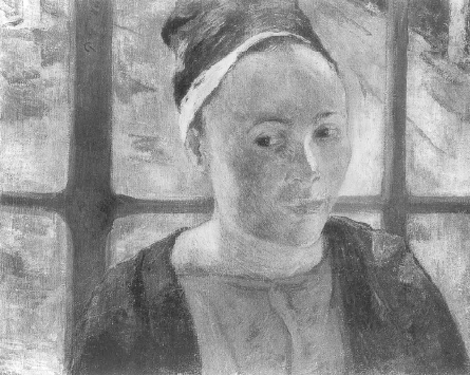 fig. 1
Paul Gauguin, Presumed portrait of Marie Lagadu, 1888, present location unknown | |
[pagina 41]
| |
Authentic Gauguins: avant-garde originality and the catalogue raisonné
| |
[pagina 42]
| |
financial stakes involved these days in the case of a Van Gogh or a Gauguin exacerbate the situation. For the historian, however, inauthenticity, misattribution and falsification are potentially of great interest: they can teach us much about the artist's work, its influence and reception. In this respect, it would be very helpful if we returned to the practice of the earliest catalogue raisonnés and included rejected works in an appendix.Ga naar voetnoot6 The task of the oeuvre catalogue is to constitute through the body of works the individual creative artist. From that point of view, any inclusion in the catalogue of significant misattributions and any omission of important works reflect incompletely assimilated, contradictory conceptions of the oeuvre. This can, though, have the positive effect of shattering the monolith of the catalogue raisonné, with its exclusive focus on the artist-subject, once again opening the finality of the oeuvre to the debates of history. Misattributions and omissions are discontinuities in the Foucauldian sense, which can be used to disturb the narrative of the individual artist's development of a personal style traditionally constructed by art history, in favour of an examination of style and technique, as well as subject matter, as shared structures of a particular visual culture, a discursive formation in an archaeology of knowledge.Ga naar voetnoot7 It is a pity that the study of Gauguin's work has been so badly served by the Wildenstein Institute's production of a catalogue raisonné. The first, published in 1964, was so flawed that the projected second volume of works on paper was never published. Merete Bodelsen, in particular, pointed out a host of misdated works, forgeries and omissions, noting that too many decisions had been made based on photographic archives rather than fresh research and examination of the originals.Ga naar voetnoot8 Thirty-seven years later, Wildenstein have begun to publish a new catalogue raisonné after a protracted attempt to rewrite the old one, most importantly with the assistance of Douglas Cooper in the 1970s and 80s. The first part in two volumes, taking the work to 1888, appeared in October 2001, and is, in general, reliable. Accepting the criticism of Bodelsen and others, the catalogue corrects dating, now starting the artist's painting career accurately in 1873. It adds many paintings to the oeuvre, enlarging it by as much as 35% before 1879, when Gauguin joined the impressionist group, and by about 18% between 1879 and 1885, before his stays in Brittany. Problematic pieces have been eliminated, notably the paintings of Charles Laval, Gauguin's companion in Central America, which had swelled the Martinique corpus well beyond the ‘dozen’ reported by the artist himself. However, one misattribution, with a forged signature, persists to distort the artist's oeuvre and the art history of the avant-garde in a revealing way (see below). Despite substantial improvements, the Wildenstein Institute's approach remains archive and provenance oriented: all the Gauguin expertise is in-house, with the recent achievements of academic and technical art history largely unassimilated.Ga naar voetnoot9 Today we have a more fully documented idea of Gauguin's career and interaction with contemporary artists and critics than was available in the 1960s. The precise moment of his engagement with Camille Pissarro and the impressionists can be fixed to the spring of 1879; his exchanges with Emile Bernard and Vincent van Gogh have been extensively researched in recent publications. The Wildenstein team uses these turning points, although not necessarily the scholarship, to structure its publication, which is, in effect, a monograph on the artist as well as a catalogue raisonné. This is an interesting development, reflecting the search for a wider audience for such publications. Significant enlargement of the early oeuvre invites us to rethink Gauguin as an ambitious artist before he | |
[pagina 43]
| |
joined the impressionists in 1879. He now emerges convincingly as a full-time artist before Brittany, in 1884-85 in Rouen, where he had moved with his family once he had lost his office job, in search of cheaper living and patronage. This is relatively unexplored territory and marks a growing interest in the early Gauguin, as the other phases of his production have been fully analysed and collected. Even among his well known Breton paintings, there are many revelations in the Wildenstein catalogue: for 1888, for example, there are new inclusions such as Presumed portrait of Marie Lagadu (W 290; fig. 1) and Breton boy (W 295), and works newly available in good colour reproductions such as Study of a woman of Pont-Aven, perhaps Marie Louarn (W 293, formerly W 244). Gauguin's Breton pictures can now be seen in the context of the tremendous popularity of this subject at the Paris Salons of the 1880s and the numerous artists' colonies established in Brittany. Scholars have worked hard to distinguish the works of the different artists of the Pont-Aven group, whose other centre became Le Pouldu, as Gauguin sought a less popular site more amenable to his primitivising aims. The challenge for the next volumes of the Wildenstein catalogue will be to identify the authentic Gauguins among the school pieces. Technical information has been used successfully to distinguish their works, even though one would expect contemporary artists with a shared aesthetic to be using very similar materials. X-radiographs and cross-sections can help document an artist's characteristic way of working by revealing brushwork and build-up of paint layers.Ga naar voetnoot10 Paul Gauguin's art and writings suggest that for him originality and authenticity were first and foremost a result of the conception of the work of art, and only secondarily of its style and technique. Even after he had finished his years of apprenticeship learning from others as an amateur painter, he continued to appropriate techniques - from the impressionists, especially Cézanne, and most notoriously, Emile Bernard's cloisonism. In 1889-90, he encouraged the artists staying with him at Le Pouldu to paint still lifes and plein-air landscapes by inviting them to ‘make a Cézanne.’Ga naar voetnoot11 Earlier, in a letter of 1881, he had jokingly urged Camille Pissarro to drug Cézanne and find out his secret ‘formula.’ Cézanne was not amused and suspected the upstart of wishing to steal ‘his sensation.’Ga naar voetnoot12 Gauguin's use of readymade artistic techniques as formulas could turn to parody, as in the derisive Still life: ‘Ripipoint’ (W 376) painted in a neo-impressionist technique for display at the Glouannec Inn in Pont-Aven.Ga naar voetnoot13 Gauguin's ironic attitude made other avant-garde artists nervous and angry; questioning his originality, they repeatedly accused him of stealing their inventions. For his part, Gauguin accused impressionism of having become a new orthodoxy and claimed that in his work he had sought ‘to dare anything to liberate the new generation.’Ga naar voetnoot14 Gauguin's painting was transformed between 1886 and 1888 by his close exchanges with Bernard and Van Gogh. There was much discussion in the winter of 1887-88 when Gauguin may have dedicated a small gouache study of a bretonne (private collection) ‘à l'ami Bernard.’Ga naar voetnoot15 Gauguin worked with Bernard in Pont-Aven in the late summer and early autumn of 1888, where they produced such related major paintings as Vision of the sermon (W 245, Edinburgh, National Gallery of Scotland) and Breton women in a meadow (private collection) respectively. They even collaborated on the carved and painted decoration of an armoire in 1888.Ga naar voetnoot16 Nevertheless, Bernard broke with Gauguin in 1891 when it became clear that the latter was being hailed as leader of ‘symbolism in painting,’ without any place for Bernard - or Van Gogh for that matter - in the narrative.Ga naar voetnoot17 Late in life, Bernard complained that he | |
[pagina 44]
| |
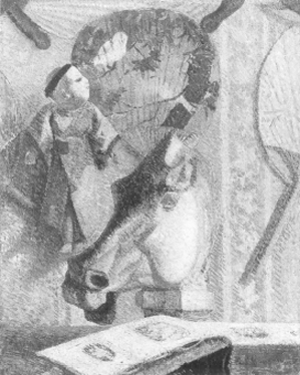 fig. 2
Artist unknown (Emile Schuffenecker?), Still life with horse's head, c. 1886, Tokyo, Bridgestone Museum of Art, Ishibashi Foundation had found one of his own paintings on exhibition with a false Gauguin signature.Ga naar voetnoot18 Actually, this has not been much of a problem, perhaps because Bernard, who lived until 1941, policed exhibitions and the market. The issue was really one of priority in developing a new avant-garde style in 1889, labelled synthetism; any synthetist painting given to Gauguin that was really by Bernard reawakened his sense of having had his invention stolen. Until his death, Bernard campaigned to win recognition as originator of the new style; sadly, in the process, he falsified chronology in both texts and images, antedating and reworking many. Art historians have chosen to take sides in the issue of contested originality, rather than focusing on the light this quarrel sheds on the dominance of originality in the politics of the avant-garde and in the writing of modernist art history. Gauguin's appropriative behaviour has been interpreted psychologically, as an instance of his untrustworthy character and lack of artistic originality; it might be more useful to consider it historically and aesthetically, as a response to the competitive avant-garde milieu of 1880s and 90s Paris, and as a search for a symbolist visual mode. Gauguin's approach was synthetic and the results often hybrid. A recognisably individual visual language was not the outcome of a consistent technique or style, as with the impressionists or neo-impressionists. Gauguin freely used a number of different styles and techniques. The imagery | |
[pagina 45]
| |
of his paintings, based on a substantial collection of source motifs, was similarly heterogeneous and appropriative. Richard Field has argued that Gauguin thought primarily in terms of paint and colour, and that in order to ‘crystallise his ideas,’ he carefully composed his images, often repeating or borrowing readymade motifs.Ga naar voetnoot19 Thus his paintings pose particular problems of authenticity for the viewer, collector and scholar, and challenge modernist notions of originality as a formal quality bespeaking expression and experiment. The 1880s and 90s were a moment of intense avant-garde competition for artistic leadership and market share in Paris, provoked by the emergence of the neo-impressionist group at the last impressionist exhibition in 1886.Ga naar voetnoot20 Gauguin's quarrel with the neo-impressionists has become a touchstone in evaluating his art. He broke with the group, which included his impressionist mentor Camille Pissarro, after Seurat had barred him from Signac's studio, unaware that the latter had given him access. It is quite likely that Seurat took this action because he suspected Gauguin of artistic espionage, of opportunistically seeking to examine Signac's neo-impressionist paintings. Seurat was inordinately secretive about technique. Gauguin, quick to take offence, thereafter never missed an opportunity to ridicule neo-impressionism, setting himself and his colleagues in opposition on the competitive Parisian avant-garde art scene. Yet, in the winter of 1885-86, he had referred to the new artists in a letter to his wife Mette Gad as a noteworthy addition to the impressionist group.Ga naar voetnoot21 Is it possible that Gauguin tried out the neo-impressionist technique before he quarrelled with the group? There is no textual evidence to suggest that he did so, and apart from the painted parody ‘Ripipoint,’ the one neo-impressionist painting that has been attributed to Gauguin is not actually by him - despite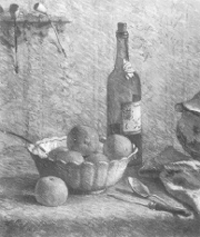 fig. 3
Emile Schuffenecker, Still life with bottle and fruit, 1886, Otterlo, Kröller-Müller Museum its inclusion, once again, in the Wildenstein catalogue raisonné. Still life with horse's head (W 216, formerly W 183; fig. 2) is surely a painting by Emile Schuffenecker, as a comparison with his Still Life with bottle and fruit of 1886 suggests (fig. 3). The two share a chalky palette, insistent directional brushwork and a careful recessional arrangement of objects in a shallow space. The wallpaper is very similar and we find the Japanese fan and photo album in another Schuffenecker still life (currently on the art | |
[pagina 46]
| |
market), which the Wildenstein catalogue reproduces. Still life with horse's head has been given a false signature, bottom right; the old one has probably been obscured bottom left. Wildenstein notes that ‘the signature would seem to be restored.’ That is a disturbing and irresponsible comment to find in an oeuvre catalogue; after raising suspicion, the authors do not pursue the issue! A simple request to the museum for some photography in infrared and ultraviolet light, and perhaps some scientific analysis if warranted, would help establish the status of the ‘Gauguin’ signature and more than likely reveal the original Schuffenecker one opposite it. I must admit, however, that when the painting was with an Amsterdam dealer in 1986, I tried to convince him to permit such a scientific examination without success. Arguments for and against the attribution of the still life to Gauguin have been closely bound up with interpretations of the artist's character and intentions. Still life with horse's head has remained in the oeuvre supported by elaborate iconographic readings (e.g., a derivation from Whistler's ‘Ten o'clock lecture’) and the image of Gauguin as an opportunist, or in the Wildenstein catalogue's more diplomatic language, as making a ‘union prudente’ with the neo-impressionists. I would argue that Gauguin did not opportunistically adopt neo-impressionism and then cynically pick a fight with Pissarro and Seurat. Temperamentally, he must have found their scientific technique incompatible with his own artistic aspirations to express emotion and mystery, so clearly set out in the Rouen sketchbook of 1884-85.Ga naar voetnoot22 Reading the document quite differently from the Wildenstein team, I find that in a text attributed to a Turkish painter called Vehbi Zunbul Zade, which Gauguin circulated among the neo-impressionists and whose author he may well have been, he poked fun by implication at the meticulous approach of the neo-impressionists. Seen in a broader perspective, Still life with horse's head reflects neo-impressionism's irruption on the Paris art scene at the time of the last impressionist exhibition in 1886 and the immediate and extensive influence it had on the avant-garde. The painting's insertion into Gauguin's oeuvre responds to a desire for a complete developmental narrative in the artist's career, which would have him progress from an assimilation of impressionism through a study of Cézanne and neo-impressionism to his own version of post-impressionism. The Wildenstein catalogue places an enlarged detail of Still life with horse's head as a frontispiece to the section on ‘Gauguin's return to Paris, 1885-86,’ emphasising the pointillist and divisionist technique and using it to mark another stage, albeit a brief one - January-June 1886 - in his development. As soon as they became aware of it in 1886, both Schuffenecker and Bernard experimented with neo-impressionist technique, as did Van Gogh. It has been suggested that Gauguin ignored Bernard when they first met in Brittany in the late summer of 1886 because he was working in a manner close to neo-impressionism. The Pont-Aven group around Gauguin, who heaped scorn on the rival circle and its technique, tolerated no such practice. In view of this history, Still life with horse's head would certainly not have been accepted as a Gauguin during the artist's lifetime (1848-1903). The still life, then owned by Hjalmar Gabrielson of Göteborg, Sweden, was first exhibited as a Gauguin in 1926, but does not reappear in the Gauguin literature until 1950, after Bernard, Denis and Sérusier had passed from the scene. When was it given a new signature and turned into a Gauguin? It would help if we knew when the still life entered the Gabrielson collection and who sold it to him. There was a market for Gauguins in Scandinavia already at the beginning of the 20th century. The early date of its change to a Gauguin, the fact that it was not proposed as a painting by Seurat, Signac or another neo-impressionist, and its unique status as the only painting attributed to the artist which accepts neo-impressionism, all point to the still life's origin with an unscrupulous insider, an early, knowledgeable source. As recent debates about Van Gogh forgeries and the research of Jill-Elyse Grossvogel have shown, there is a Schuffenecker problem affecting the art of Van Gogh, Gauguin and Cézanne.Ga naar voetnoot23 In the 1890s, Emile Schuffenecker acquired a sizable collection of their works. According to Grossvogel, he was forced to sell the collection to his brother Amedée in 1904, due to the financial burden of his divorce settlement. Emile made copies and variants of the works in the collection; a number of these have recently been published and exhibited as his work. When and why these were produced is unclear. Some may have been made innocently as exercises or souvenirs, as in the case of the pastel Copy of Van Gogh's ‘Self-portrait | |
[pagina 47]
| |
with bandaged ear’ (Amsterdam, Van Gogh Museum); others, such as the Van Gogh pastiche Workers in the field (Lillian Heidenberg Gallery), are more problematic.Ga naar voetnoot24 Were they made as an homage by an admiring artist, or as records when the collection was sold to his brother? Grossvogel suggests that some may have been deliberately reattributed and sold by Amedée, who had acquired them with his brother's collection and become a dealer. Was Emile involved with his brother in the dubious practices that would have turned such pieces into ‘originals’? Grossvogel notes that he admitted to retouching and completing Cézannes and I shall argue below that he also ‘improved’ a Gauguin by enlarging it. Emile Schuffenecker was certainly tainted by association with his brother's practices. Grossvogel suggests he had the classic forger's motivations of artistic resentment as an unsuccessful artist and contempt for the speculative buyer. Attractive as such hypotheses may be, the paintings are our only documentary proof. Based on a substantial collection of originals, such forgeries will continue to be hard to detect through provenance or scientific analysis, which could reveal the inclusion of non-period materials, since these works share provenance and period materials with genuine works. Of course, not all of the dubious works from the Schuffenecker collections may be by Emile; other artists from the Pont-Aven group should be considered as possible authors. Still life with horse's head is, I believe, a genuine Schuffenecker given a false signature. There are a number of Pont-Aven school paintings in the first version of the Wildenstein oeuvre catalogue from 1964, noted by Bodelsen, which aspired to become Gauguins by a similar subterfuge. However, there is another type of false Gauguin, typical of the history of forgeries and misattributions: the copy, the variant or the pastiche, some possibly made as learning exercises and later given false signatures and dates. Still life with Delacroix reproduction (W 257, formerly W 535; fig. 4), moved from 1895 to 1887 in the new oeuvre catalogue, does not seem any more convincing as a Gauguin when set in a Martiniquan context. The Wildenstein catalogue indicates that it may have come from the Schuffeneckers. There were many fine Gauguins in the Schuffeneckers' collection, but that provenance now raises as many questions as it answers. Gauguin admired Delacroix, as is clear from his letters and writings, an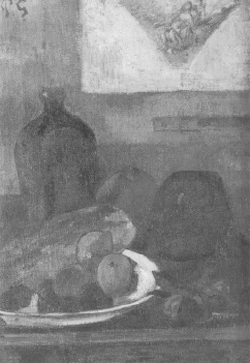 fig. 4
Artist unknown, Still life with Delacroix reproduction, Strasbourg, Musée des Beaux-Arts | |
[pagina 48]
| |
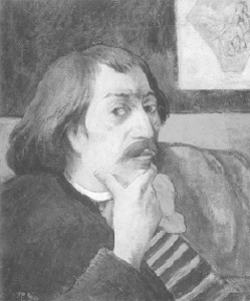 fig. 5
Artist unknown, Self-portrait with Delacroix drawing, Detroit Institute of Arts interest that probably started as early as the 1870s. He copied La mulûtresse (Aline) (Montpellier, Musée Fabre) in 1883 and quoted Delacroix's figures, faces and gestures throughout his career, especially during his second Tahitian trip. In a couple of impressionist still lifes, Gauguin reproduced paintings and drawings by other artists from his own collection as part of the interior setting. In his symbolist works, the quoted material had to support his imagery; mostly, he preferred his own works because they fit the symbolism of his paintings better. Iconographically, the Delacroix drawing in the Strasbourg still life, which depicts the Expulsion of Adam and Eve from the Garden of Eden for a pendentive decoration in the senate library at the Palais du Luxembourg in Paris, is incompatible with Gauguin's symbolism, as will become clear at the end of this article. The Delacroix also turns up in the background of a Self-portrait (fig. 5), a painting rejected by the 1964 catalogue as a 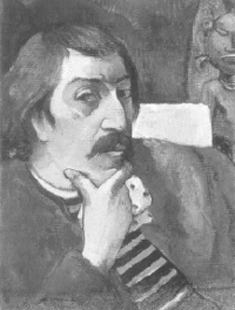 fig. 6
Paul Gauguin, Self-portrait with idol, c. 1894, San Antonio, The Marion Koogler McNay Art Museum copy of Self-portrait with idol (W 415; fig. 6). Wildenstein have it right in that case.Ga naar voetnoot25 Before Gauguin's Human miseries (W 304; figs. 7 and 8) was exhibited in Vienna in 1907, someone added a three-centimetre canvas strip of different weave from the original coarse jute to the left edge in an attempt to ‘improve’ Gauguin's composition.Ga naar voetnoot26 Unfortunately, this information is not available in the Wildenstein catalogue, although careful examination of the reproduction might raise suspicions. We now know that the Schuffeneckers enlarged the Seji Togo Memorial Sompo Museum of Art's Sunflowers and several other paintings.Ga naar voetnoot27 I suspect that it was Emile Schuffenecker who painted the strip and had it added to enlarge Human miseries. He was listed as the owner in the Vienna catalogue and his name is inscribed on the stretcher. Gauguin had shipped the painting from Arles to Theo van Gogh at Boussod's Montmartre gallery, | |
[pagina 49]
| |
where Schuffenecker saw it in November 1888. It could not be exhibited because it was flaking badly, as he pointed out in a letter to Gauguin. The artist reattached the paint early in 1889 and shortly after Schuffenecker bought Human miseries. At a later date, probably just before it was sent for exhibition in Vienna, Schuffenecker had it lined, presumably to prevent further paint loss; he seems to have taken the opportunity to enlarge the painting to a standard size format, extending the figure of the Breton woman on the left. This is probably also the moment when two variants based on the bretonnes in the foreground, documented in the Witt Library photographic files, were made, in an effort to produce paintings compatible with Gauguin's practice of reusing figures. In all cases, precise technical information about Gauguin's paintings should have been requested from owners and included in the Wildenstein catalogue raisonné; it would help collectors and scholars make informed judgments about the paintings.Ga naar voetnoot28 After the achievements of 1888, 1889 was another very productive year for Gauguin, in which he elaborated his new synthetist approach and consolidated his pictorial symbolism. This was also the year in which he became the highly visible leader of a group of artists all working in a similar manner. Separated from Bernard and Van Gogh, he did not benefit from as rich and stimulating an artistic dialogue; nevertheless, his interaction with Jacob Meijer de Haan and Paul Sérusier made his Breton stay of 1889 very fruitful. Gauguin used plein-air landscape and studio still life to teach his followers a new way of painting. He enjoyed being ‘the master’ and generally seems to have been accorded that role and even the title. In that sense, the term ‘Pont-Aven School’ seems warranted. In October 1888, he gave his most famous lesson to Paul Sérusier, who painted the small landscape that subsequently became known as The talisman; he showed this to his colleagues in Paris, catalysing the formation of the Nabis.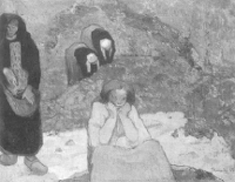 fig. 7
Paul Gauguin, Human miseries, 1888, Copenhagen, Ordrupgaard Samlingen 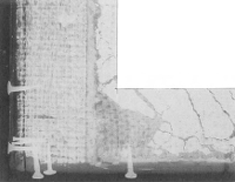 fig. 8
Detail of x-ray of Paul Gauguin, Human miseries | |
[pagina 50]
| |
The story has come down to us as narrated by Maurice Denis, who summed up the painting lesson in the notion of ‘equivalence’ as opposed to imitation, a concept he credited to Cézanne.Ga naar voetnoot29 A look through the catalogue for the pioneering 1966 Arts Council exhibition on Pont-Aven is most instructive.Ga naar voetnoot30 Although the entries are organised traditionally by artist, starting with the ‘master’ Gauguin and his chief associate Bernard, the illustrations are frequently grouped by genre and theme, making the interaction and learning immediately apparent. In 2002, the Wadsworth Atheneum's wonderful exhibition Gauguin's nirvana made just that point by hanging still lifes by Gauguin and Meijer de Haan side by side, and by setting their Pouldu landscapes next to those of Paul Sérusier.Ga naar voetnoot31 Both exhibitions documented the intensive artistic exchange taking place around Gauguin in Brittany and underlined the challenges of distinguishing authentic Gauguins from the works of colleagues and students - the task faced by the next volumes of the Wildenstein oeuvre catalogue. In some cases, authorship and the relations of copy and original have only recently been elucidated. What is a problem for the author of the catalogue raisonné is, from the historian's point of view, however, an opportunity to understand the shared aesthetic and cultural ideas of the artists around Gauguin. Painting still lifes was a way of learning the new synthetist approach that Gauguin promoted. He used Cézanne's paintings as a model and may have had with him in Brittany as an example Still life with compotier (Paris, private collection), which he had brought from Copenhagen as a precious remnant of his own art collection when he returned to Paris in 1885.Ga naar voetnoot32 Some of Gauguin's still lifes, such as Still life with apples, pear and ceramic jug, 1889 (W 405, Cambridge, Harvard University Art Museums) are set pieces, veritable exercises in the manner of Cézanne; others, such as Still life with three puppies, 1888 (W 293, New York, Museum of Modern Art), are imaginative inventions using personal imagery in which the Cézannesque coexists with other modes. The earliest example of such inventive use of Cézanne's ‘formula’ is Still life with profile of Laval, 1886 (W 207, Indianapolis Museum of Art), and they become numerous starting in autumn 1888. Welsh-Ovcharov has shown how closely Meijer de Haan studied Gauguin's approach in a number of Cézannesque still lifes from 1889, comparing, for example, Harvard's painting with De Haan's Still life with apples and a vase of flowers, c. 1890 (private collection).Ga naar voetnoot33 In some cases, an artist actually copied a painting by Gauguin in order to learn. Long given to Gauguin, Still life with onions of 1889 (W 380, Copenhagen, Ny Carlsberg Glyptothek) appears to be a learning copy by Meijer de Haan now that the original has turned up.Ga naar voetnoot34 Such a traditional teaching practice included the making of copies of landscapes as well. The still lifes are, on the whole, closer in appearance to Cézanne's work than the landscapes and figure paintings. Nevertheless, in these genres as well, his paintings served as a paradigm for studying and representing nature. In 1884-85, Gauguin characterised Cézanne as ‘a man of the south who spends whole days on the summits of mountains reading Virgil,’ and his landscapes as richly suggestive because of their grave colour and mysterious | |
[pagina 51]
| |
forms.Ga naar voetnoot35 When the Pont-Aven artists went out to paint en plein air, Gauguin's approach and his lesson seem to have been: observe and think about the motif, selecting and simplifying to arrive at the image, and then complete the painting all at one go. This might mean taking notes in a sketchbook, as Gauguin often did, perhaps painting the design in outline with dilute blue paint in the studio and then returning to produce the final painting from the motif without interruption.Ga naar voetnoot36 Several thinly painted works, such as Berger et bergère dans le pré, 1888 (W 250, Brussels, Musées royaux des Beaux-Arts) and some unfinished canvases such as View of Pont-Aven from Lézaven, 1888 (W 370, private collection) show clearly how the artist proceeded. Equally, we can observe painters such as Sérusier and Meijer de Haan applying this synthetist mode in their landscapes, e.g. Sérusier's The quarry of 1890 (Ottawa, National Gallery of Canada). A number of landscapes document the artists' sharing of motifs and landscape sites, even if they rarely painted side-by-side at the same time, e.g. Gauguin's and Meijer de Haan's paintings of the valley of Kerzellec.Ga naar voetnoot37 In a few cases, as with the still lifes, Gauguin's landscapes were copied as a learning experience. Travers Newton and I were able to study a curious case in 1987. There are two versions of Entre les lys. The one formerly in the Staechlin Collection (W 366) is clearly signed and dated 1889; the other (private collection) is not. They are identical in every respect except colour; the unsigned work, executed in a richer and thicker paint layer, has quite extensive passages of violet and pink in the foreground that are lacking in the signed version. In 1987, Paolo Cadorin argued that the signed painting included the fugitive pink dye eosin as a lake pigment, which had faded, whereas the stable pigments used by the copyist, unaware of Gauguin's precise choice, did not.Ga naar voetnoot38 It is, in fact, possible to reconstruct the following scenario: the Danish artist Gad Frederik Clement, whose family owned the painting until it was bought by the collector who asked us to examine it, had come to Paris in 1890 to study art. His friend Fritz Bendix was the first owner of Gauguin's signed Entre les lys, which had been acquired for him at the artist's 1891 auction and, presumably around that time, Clement made a copy of it in order to become familiar with Gauguin's technique. The painting that turned out to be a copy preserves important information about the original appearance of the Gauguin. A similar problem with a fugitive pigment in a gouache by Gauguin led, initially, to the opposite conclusion being drawn, because the changes in the work of art were not taken into consideration. Young Breton girl by the sea (private collection), clearly signed ‘P Gauguin’ and dated ‘1889’, was initially rejected by Daniel Wildenstein because it did not look strong enough to be by the artist; after publication of a technical study, it has been accepted and will appear in the forthcoming volume of works on paper.Ga naar voetnoot39 Scientific examination and technical photography by Thea Burns confirmed that the paper support of Young Breton girl by the sea has darkened, and that the bretonne was much more forcefully modelled and the landscape more brightly coloured before the fugitive red pigment faded. Some of the original, unfaded colour is preserved and can be seen where the rebate of the frame protected it | |
[pagina 52]
| |
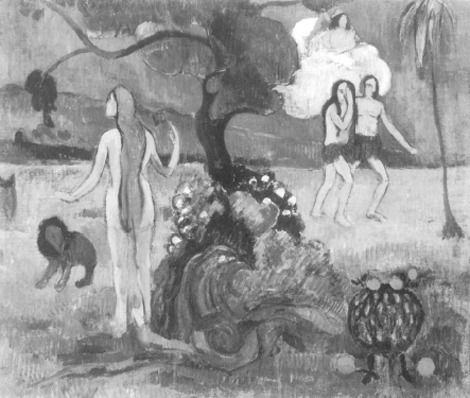 fig. 9
Artist unknown, Paradise lost, New Haven, Yale University Art Gallery from light. The gouache relates closely to a painting from Le Pouldu (W 340, Tokyo, National Museum of Western Art) and the full-size study drawing for it (W 341, private collection). This no doubt increased suspicions, despite the very genuine looking signature and date. It was Gauguin's frequent practice to reuse studies and full-size cartoons to make independent works, as in the case of the well-known paintings of nude bathers from 1889.Ga naar voetnoot40 Fading is not an indication of a genuine Gauguin, of course. However, such technical study reminds us that we are not seeing any painting in its original condition, as the artist completed it, and that the artist had no sure way of gauging the changes to come - as Anne Hoenigswald has pointed out in Van Gogh's case.Ga naar voetnoot41 This is particularly true for the many fugitive lakes and new 19th-century pigments. It is therefore crucial that judgements about authenticity be informed by scientific examination and technical understanding, combined with visual experience and historical study. Viewing a painting is an act of interpretation; understanding it historically necessitates an act | |
[pagina 53]
| |
of reconstruction as part of that interpretation. It is not feasible to do scientific examination on every Gauguin. However, so many have been examined that it is possible to be an informed observer and ask the right questions. It is a great pity that oeuvre catalogues do not systematically ask for this information and use it as a fundamental source of data for evaluating and understanding works of art. I shall conclude with an example that does not involve scientific data, but in which the imagery is decisive. Paradise lost (fig. 9) is clearly related to the work of Gauguin and his followers in Brittany in its synthetist mode and religious subject matter, but the specific technique and imagery seem hard to reconcile with his authorship.Ga naar voetnoot42 Although they imitate Gauguin's technique, the crude outlines, heavy brushwork, the thick paint and dull colour are remote from Gauguin's works of 1889-90. The poses and gestures of the figures mimic the newly developed body language of his images based on Southeast-Asian Buddhist sculpture; but in the Yale painting, they lack the forcefulness and clarity of those gestures and poses. The painting is a direct response to Gauguin's decorations in the dining room of Marie Henry's inn at Le Pouldu. In the centre of the Yale painting, identified by the hidden imagery of eagle and serpent, the Tree of the Knowledge of Good and Evil divides the scene in half. On the left. Eve addresses some creatures that look like an owl and a lion; this might be a reference to prelapsarian dominion over the animal kingdom.Ga naar voetnoot43 In her stance, Eve could be the figure from Gauguin's painted door panel Caribbean woman (W 330, private collection) turned around to face into the image. The different arm gestures may reflect the figure in Exotic Eve (fig. 10), as does the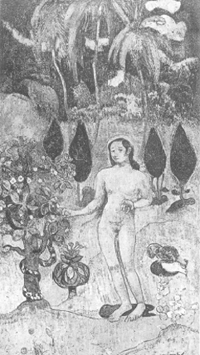 fig. 10
Paul Gauguin, Exotic Eve, 1890, private collection | |
[pagina 54]
| |
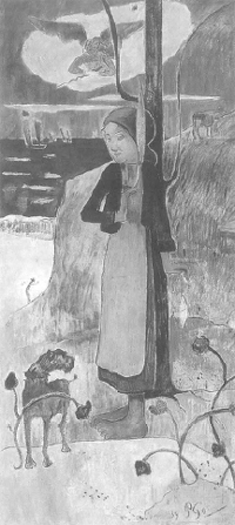 fig. 11
Paul Gauguin, Breton girl spinning, 1889, private collection lush, magical foreground setting with palm tree and flowering and fruiting bushes. The right half of the painting shows the expulsion from the Garden of Eden. The angel, up to his chest in cloud at the top right, is a cousin of Gauguin's sword-toting angel in the mural Breton girl spinning (W 329; fig. 11). Both cloud-borne angel and the poses of Adam and Eve are reminiscent of the so-called Italian primitives of the 14th and 15th centuries, who were admired in this circle of artists. The Yale painting clearly reflects the artistic milieu of Le Pouldu and the debates about art and religion that went on there in its subject matter. Though it was included in the 1964 Wildenstein oeuvre catalogue, I do not believe the painting is by Gauguin - in large part because of that very imagery. The treatment of the subject in Paradise lost is quite at odds with Gauguin's radical revision of the imagery of the Fall. He questioned the moral lesson that Christianity drew from the biblical story by visualising the consequences of the Fall in the anguished nudes of 1889 such as Woman in the waves (Ondine) (W336, Cleveland Museum of Art). In Exotic Eve (fig. 10), he rejected traditional western morality for an exotic vision of paradise in which acceptance of sexuality is the centre of an untroubled realm of plenty.Ga naar voetnoot44 The Yale painting now known as Paradise lost (fig. 9) is described in Marie Henry's account as reported by Henri Motheré; it is mistakenly given the title Earthly paradise, which its imagery of temptation and expulsion certainly does not support. It is the painting known today as Exotic Eve that represents an earthly paradise.Ga naar voetnoot45 Even if we no longer attribute it to Gauguin, Paradise lost is still of great interest to the historian. Whoever may have painted it, it shares its use of esoteric religious imagery with the circle of art- | |
[pagina 55]
| |
ists working with Gauguin at Marie Henry's inn in Le Pouldu.
Misattributions and forgeries affect all of Gauguin's oeuvre, from his amateur beginnings through the impressionist and Breton periods to the South Sea sojourns. Most readily collected, therefore most valued and most likely to be forged, have been the Tahitian and then the Breton paintings.Ga naar voetnoot46 There are no doubt questionable Tahitian paintings, drawings, prints and sculptures; however, it is the Breton period that has been the largest and earliest source of dubious paintings by Gauguin. His role as leader and teacher at Pont-Aven and Le Pouldu led to the production of many closely related paintings and even ‘school pieces’ and copies, many of which have aspired to be Gauguins at various times. In this respect, Gauguin's oeuvre raises issues of attribution and authenticity closer to those associated with a Raphael or a Rembrandt, who ran studio workshops, than with a modern impressionist artist, a situation that reflects Gauguin's aims after impressionism and should be seen in the context of the ‘neo-traditionist’ reaction to modernism.Ga naar voetnoot47 After 1886 Gauguin's images were often based on careful preparatory drawings, which he kept in portfolios and reused throughout his career; thus, figures and poses recur in his oeuvre.Ga naar voetnoot48 Such procedures have made it relatively easy to produce a pastiche and challenging to recognise a school piece. However, a web of references to such poses and motifs does not guarantee the authenticity of a work; as we have seen, Gauguin's intense, sonorous colour is distinctive. The paintings are visualisations of his ideas and feelings; imagery and meaning are just as central to recognising authentic Gauguins as are execution, palette, figures and motifs. |
|

